FASHIONABLE HAIR DRESSING
 A POTENT factor in any woman‘s appearance is her coiffure. Indeed, no other item of
her toilette is really so influential, either to emphasize or to lessen her natural attractiveness,
since no fashion is so capable of affecting the actual expression of her countenance as is one that
pertains to the arrangement of the hair. The often-admired “crowning glory” may be
rendered almost a disfigurement if disposed unbecomingly, while a tasteful and careful dressing
of the tresses, even though they are not very beautiful, will lend a decided charm to a plain face.
A POTENT factor in any woman‘s appearance is her coiffure. Indeed, no other item of
her toilette is really so influential, either to emphasize or to lessen her natural attractiveness,
since no fashion is so capable of affecting the actual expression of her countenance as is one that
pertains to the arrangement of the hair. The often-admired “crowning glory” may be
rendered almost a disfigurement if disposed unbecomingly, while a tasteful and careful dressing
of the tresses, even though they are not very beautiful, will lend a decided charm to a plain face.
A knowledge of what is suitable and what the reverse in matters of dress is instinctive with the average woman,
and if she disregards it, there must be a lack of that amour propre which is such a precious possession.
Of course, considerable time is required to bestow the proper amount of attention upon the hair, but the result
of such care fully justifies the daily expenditure. Few women begrudge the hours required to make their gowns,
and the grooming of the hair is not one whit less important.
It is as essential to keep the scalp clean as it is to maintain the rest of the person in a state of purity, for
if the pores of the scalp were clogged, the growth of the hair would be retarded. The oily matter
that exudes from the pores would soon become thickened by the particles of dust settling upon the scalp, and the follicles
would thus be obstructed, whereas it is necessary for the health of the hair to keep them as free as possible.
The hair should be shampooed once a month, and any dust that lodges upon the scalp between the shampooings
should be removed with a moderately stiff brush. The shampooing process is simple enough,
the only difficulty being to dry the hair thoroughly. Of course, the drying process is most
tedious when the suite is very heavy, and coarse hair dries more easily than fine, since it is by nature less moist.
Before the hair is washed the dandruff should be raised from the scalp by means of a brush having stiff bristles set quite
far apart in a rubber back, which will yield to the scalp and thus render the bristles less rigid, though taking nothing
from their effectiveness.
A good shampoo may be made with pure white Castile soap, which is more beneficial than a soap that contains much alkali,
because the oil used in its manufacture is very wholesome, and enough of it remains on the hair to render it soft and
glossy. Shave the soap finely, and dissolve it in warm water, using enough soap to make a strong, thick lather,
which, for convenience, should be placed in a bottle. When ready to shampoo, pour a liberal quantity of the
liquid upon the hair and rub it well into the scalp with the fingers. When the scalp and hair have been
thoroughly cleansed, rinse them with clear water until the soap is entirely removed. It is advisable to use
warm water for rinsing, as cold water might shock the scalp enough to produce unpleasant results. After the
last rinsing, rub the hair as dry as possible with a coarse towel.
The best way to dry the hair in Winter is to spread it in the heat of a grate fire or a coal or gas stove.
The heat from a hot-air furnace is not advised, as a register usually discharges too much dust; neither is fanning
recommended, because the strong current of air thus produced often causes neuralgia and other affections. In Summer
the open air or, better still, the warm sunlight is the preferred dryer.
When the hair is perfectly dry, free it, carefully from snarls and tangles with a coarse comb, beginning by
combing out the ends and gradually working upward. If the hair is combed too near the scalp at first, it
will be far more difficult to remove the tangles, more hair will be lost, and the operation of combing
will be quite painful. Unusually dry hair is frequently softened with a little “brilliantine,” a well
known preparation, which is poured into the hollow of the hand and transferred to the hair, not the scalp,
and is then brushed through.
After the hair has been smoothly combed or brushed, clip all split ends. Clipping is more beneficial
than singeing, and is less dangerous when a woman takes care of her own hair. The fashion of bleaching
the hair has been revived, but it cannot be commended. Very often golden locks are out of harmony with
one‘s eyes and complexion, and the artificiality of the tint is then all too apparent. However, if the
bleach is desired, it must be applied once every six weeks or oftener, and to the roots only; otherwise,
the hair would grow out from the roots in its natural tint, and the effect would be anything but pleasing.
Titian blonde hair is more fashionable than yellow blonde, and those to whom Nature has given tresses in
that rare reddish tint may count themselves very fortunate.
And now regarding the arrangement of the hair. Prevailing fashions in hair-dressing may nearly always
be adapted to the requirements of the individual face. At present the protruding knot, familiarly known
as the Newport, is considered exceptionally artistic; and while the most approved location for it is
just below the crown, it may be raised or lowered to secure perfect becomingness. Thus, for an oval
face the knot may be adjusted a trifle above the crown, while the regulation disposal is suitable to
a round face, and a longish knot to a long, slender one.
In like manner, the face must be studied for the proper arrangement of the waved side-locks, which are
as important an element of the coiffure as the bang. Large, natural-1ooking waves are approved; and
when the waved hair is carried up to the knot, it should be slightly puffed out at the sides for a
full, round face, loosely adjusted when the face is oval, or drawn back, but not rigidly, from a
long, slender face. It is a common but mistaken idea that a broad effect at the sides will give
breadth to a long face; instead, such a disposal of the hair only adds width to the head and causes
the face to appear even more slender by contrast.
As to the bang, nearly every women wears it parted, although round faces are most improved by this
arrangement. With the part, curls may be worn upon the forehead, there being the prescribed number
for a long, face, while a single curl is considered best for an oval face, of which as much of the
forehead as possible should be bare.
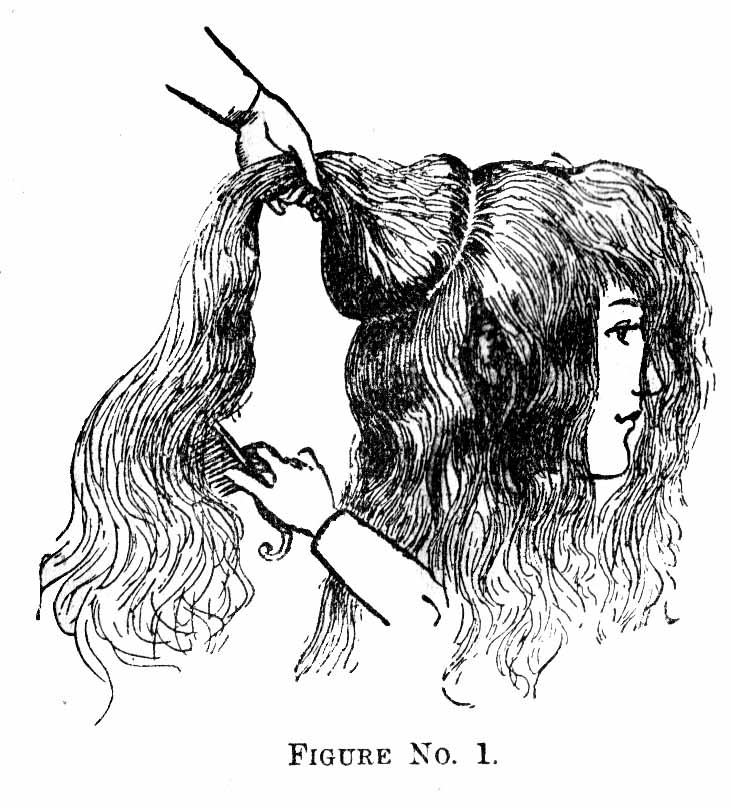 To arrange the admired Newport coiffure, first free the hair from tangles, so that the comb may be drawn through it
easily and freely, the process being as described above. Then part the hair for waving, making the part an inch
from the edge of the hair all round when the tresses are moderately thick, or only half an inch from the edge when
locks are very thick, or an inch and a half from the edge when the hair is very scanty.
To arrange the admired Newport coiffure, first free the hair from tangles, so that the comb may be drawn through it
easily and freely, the process being as described above. Then part the hair for waving, making the part an inch
from the edge of the hair all round when the tresses are moderately thick, or only half an inch from the edge when
locks are very thick, or an inch and a half from the edge when the hair is very scanty.
After that portion of the hair which is desired for waving has been divided from the rest, comb out the hair again with the
right hand and gather it into a switch with the left, as shown at figure No. 1; then turn it up, as at figure No. 2, twist
it to form a French twist, as at figure No. 3, and secure it with a hair-pin at the crown, as pictured at No. 4. In making
the French twist, comb the hair upward toward the left, roll it tightly in the same direction, and pin it as shown.
After the French twist has been made, dispose of the switch in a coil, as represented at figure No. 5, to keep
it separate from the remainder; and then begin the waving. Any kind of steel tongs that are made without springs
may be used for this purpose, and they may be heated over an alcohol lamp or a gas jet, preferably the former,
because it will not charge the iron with a deposit of soot. Before using the heated iron, rub it vigorously on
clean paper to test its heat and at the same time remove all impurities from its surface. Take up, as most
convenient, portions of the hair about half the thickness of the little finger; wind each portion separately
about the round jaw of the tongs, as illustrated at figure No. 6; and when a sufficient quantity has been
thus secured upon the iron, close the latter so as to heat the hair through and make the waves more lasting.

|
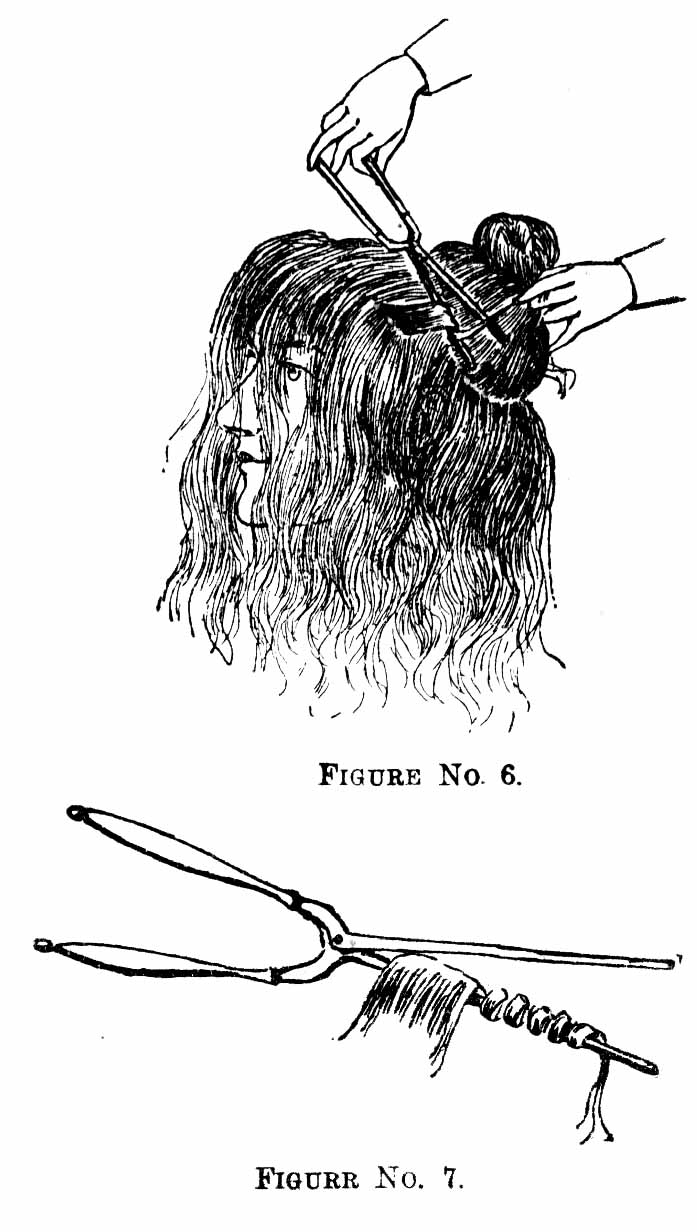
|
Wave as closely as possible to the head, and for five or six inches down on the hair and so continue
until all the loose long hair has been treated. Figure No. 7 portrays more clearly the method of
winding the hair upon the iron, and at figure No. 8 the hair is shown waved all round and the
bang combed out ready for curling. Figure No. 9 illustrates the method of combing out the waves,
a coarse comb being used.
The correct bang is slightly pointed at the center and is shorter than was formerly stylish. It is parted at the
center, and the hair at each side of the parting is divided into an upper and lower layer for curling. Arrange
the upper layer in three curls, which may turn upward or downward, as preferred. First catch in the iron the
ends of the hair to be curled and turn the iron, until all the hair has been curled round it, running it
through the hair at each side of the parting and twisting it to produce a slight wave. The lower layer
should be no more than a light fringe and should be disposed in three curls, the one at the center being
curled downward and flattened with the iron, and the one at each side being curled upward and toward the
part. This process produces a V outline.

|
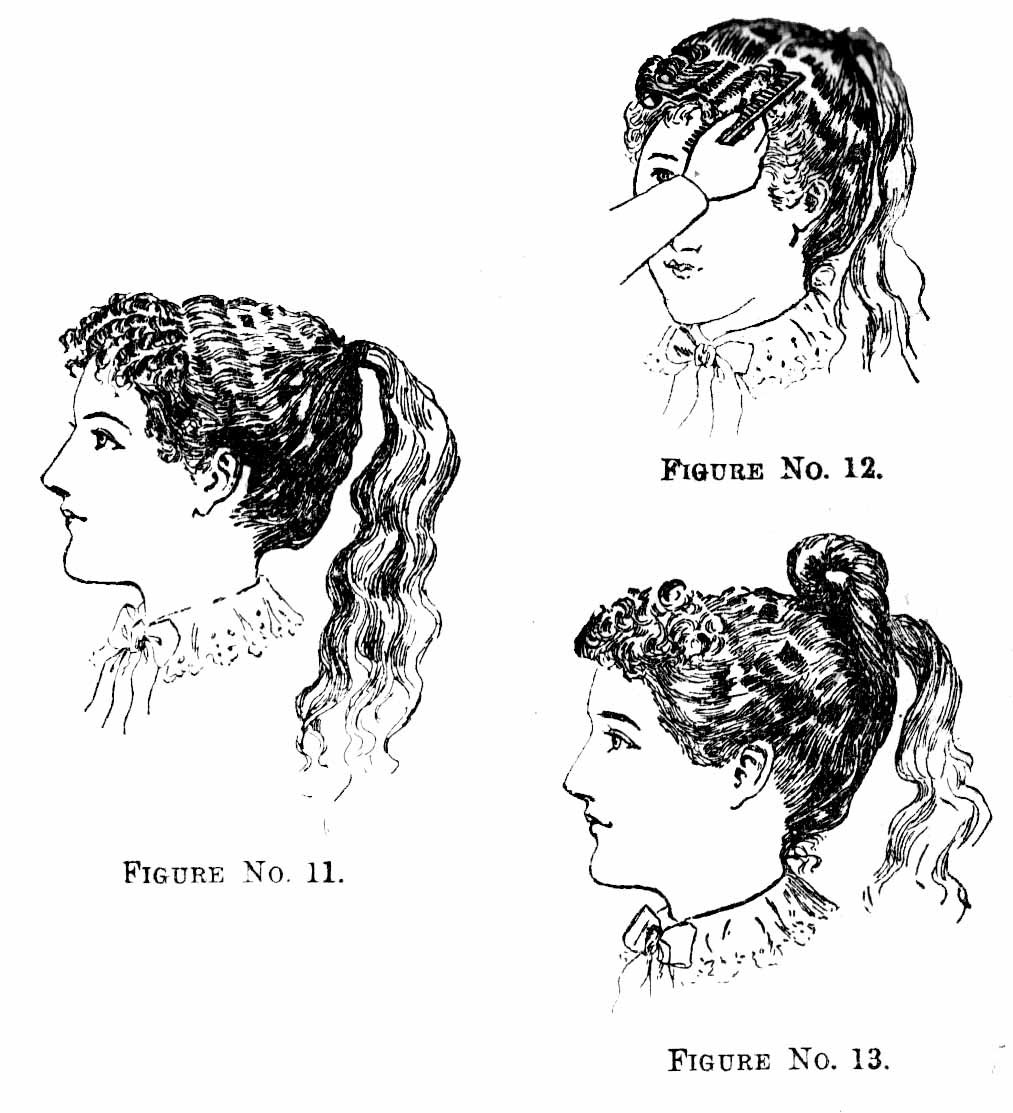
|
When the waves have been loosened to look like “Nature‘s own,“ uncoil the switch and
secure it firmly by twisting round and round it just below the crown a few: strands of hair that have
been separated from the switch at the right
side, as may be seen at figure No. 10; or use a cord instead of the hair. Then bring the waved portions back to the
switch, using the fine end of the comb; and when all have been fastened to the knot with a hair-pin, as
represented at figure No. 11, smooth the switch out once more. It will then be ready for coiling.
The bang may be combed out either before proceeding with the coiffure or after it has been completed, as best
liked. Figure No. 12 pictures the former method. Comb the bang from underneath with the fine end of the
comb at each side of the parting, and allow the center curl to hang flatly upon the forehead.
Then twist the switch tightly to the end, bring it up to the crown in suggestion of a loop, as pictured at
figure No. 13, holding the bottom of the twist with the left hand, and then coiling the remainder lightly
round the knot, which stands out from the rest, and pinning it to the head very securely, as may be observed at figure A.


The Newport knot, when properly made, is very soft and graceful. A front view of the coiffure is given
at figure B. Side-combs of shell, plain or with silver mountings, are thrust vertically through the
upper layer of the bang at both sides about half an inch from the parting. Such combs vary in length
from an inch and a half to three inches, the choice being left to personal fancy.
Figure C represents the Newport coiffure embellished with one of the new Spanish combs,
which are of fanciful outline and are very fashionable for dressy occasions. The outer hair is waved,
the coil or knot arranged, and the bang curled, as above described. When side-bangs have been cut
(they are now an extinct fashion), they are closely curled and brushed back
The Spanish comb is invariably adjusted as illustrated, but the more slender and fanciful hair-pins of
to mingle with the waves.
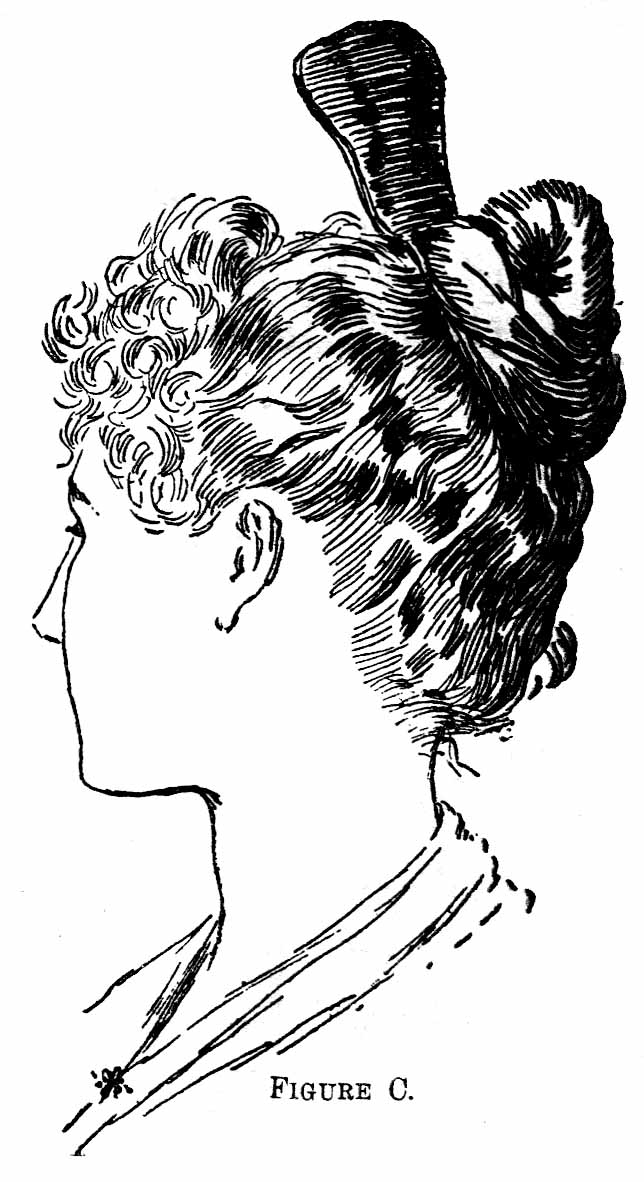 shell or silver are thrust in at the side or wherever else they will be becoming.
shell or silver are thrust in at the side or wherever else they will be becoming.
If the natural growth of hair is insufficient to render the head proportionate in appearance, the deficiency
should be supplied by an artificial switch to produce a truly artistic effect. At figure C the knot
is scarcely large enough for the head. A more correct and effective result may, therefore, be obtained
The simplicity and classic suggestion of the Newport knot, with its accompaniment of waves and curls, make this style a favorite
for both daytime and evening.
The knot gives the head a charming contour, 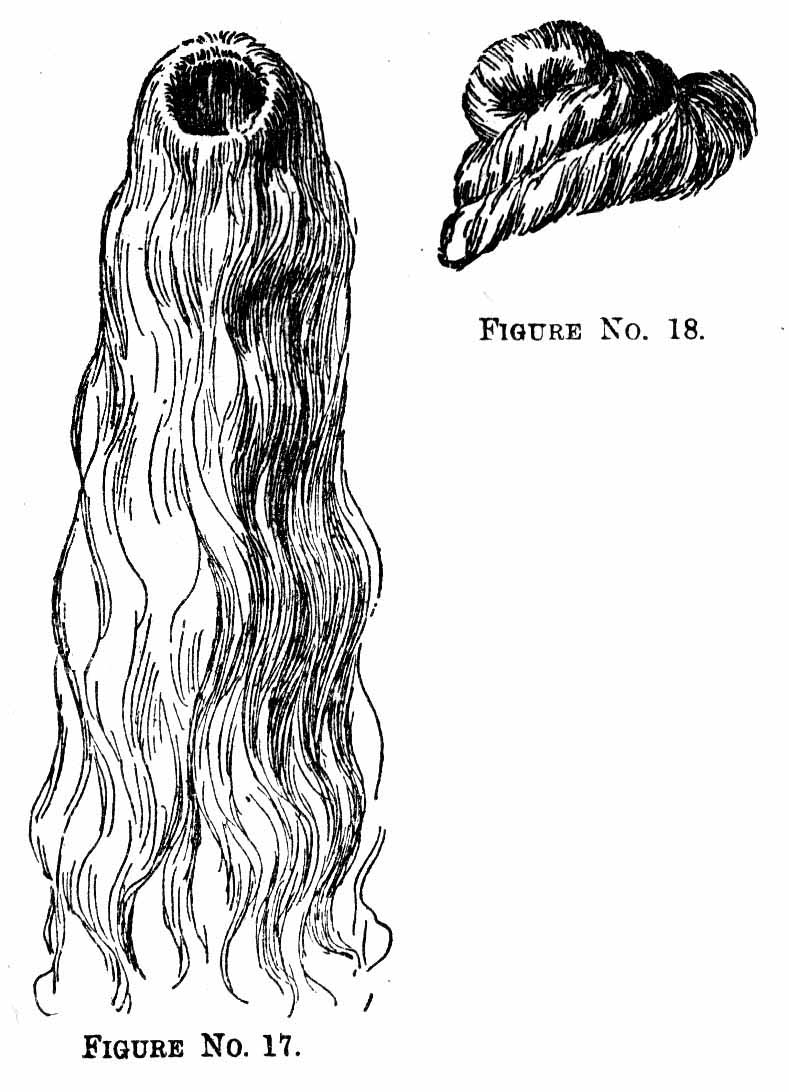 in which respect puffs and other exaggerated disposals
signally fail; and, besides, it is easy to form without the services of a maid, an advantage that appeals to the great majority of womankind.
in which respect puffs and other exaggerated disposals
signally fail; and, besides, it is easy to form without the services of a maid, an advantage that appeals to the great majority of womankind.
Figure No. 17 shows the Newport switch, which is made of long, naturally curly hair fastened to a light ring
that fits accurately over the knot of hair it is designed to cover. The switch is coiled before being
adjusted, as pictured at figure No. 18, and is then disposed over the hair, which has first been twisted
in a tight knot. The effect of the arrangement is perfectly natural, as may be seen by observing
figure D, where the coiffure is shown with the switch added, which gives the head a fulness and the
coiffure a completeness that are lacking in the arrangement seen at figure C. The Spanish comb
represented at figure D has a fancy edge. The hair may be thus arranged for any ceremonious occasion.

A very fanciful coiffure that is appropriate only with full evening attire is known as the fleur de lis and is
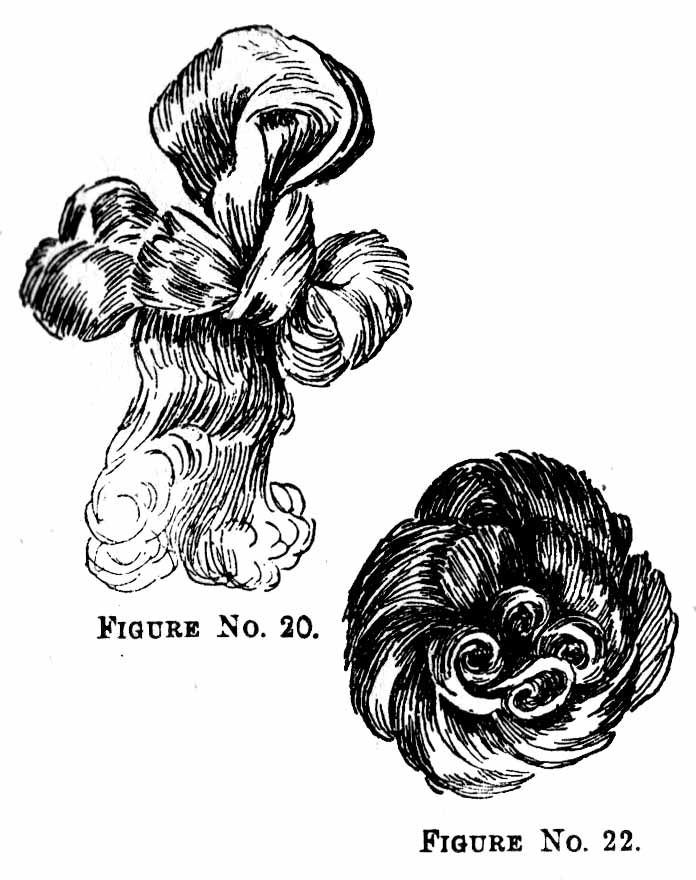 portrayed at figure No. 20. In its arrangement three switches of soft, naturally curly hair eighteen inches
long are needed. Each switch is twisted and formed in a loop, and the center one is adjusted to stand erect
and the others to protrude at the sides, while the remaining hair below the loops hangs with a slightly
curled effect. When ready for adjustment the fleur de lis, which is a close copy of the French emblem
is pinned over the knot of hair, being placed a trifle to one side to avoid a studied appearance. Thus
the trio of loops rise above the crown, and the curls fall gracefully below. The hair is waved, of course.
portrayed at figure No. 20. In its arrangement three switches of soft, naturally curly hair eighteen inches
long are needed. Each switch is twisted and formed in a loop, and the center one is adjusted to stand erect
and the others to protrude at the sides, while the remaining hair below the loops hangs with a slightly
curled effect. When ready for adjustment the fleur de lis, which is a close copy of the French emblem
is pinned over the knot of hair, being placed a trifle to one side to avoid a studied appearance. Thus
the trio of loops rise above the crown, and the curls fall gracefully below. The hair is waved, of course.

Figure E displays the effect of the fleur de lis coiffure, which can only be arranged
with the switches described. If desired, a fancy hair-pin may be placed at either side.
Figure No. 22 portrays a long switch twisted loosely in a Psyche knot, the ends of the switch curling
naturally and being drawn through the center of the knot. As in the coiffures mentioned above, the
knot may be fastened over a closely twisted “pug” of. hair without giving the slightest
hint of its artificiality.
 A low coiffure that is well adapted to a youthful face of the slender type is in the form of
an “eight,” and is a pretty variation upon the prevailing style of hair-dressing. To arrange
it, first free the hair from tangles, and then make a center parting, as shown at figure
No. 23. Hold the comb flatly in the right hand, with the teeth toward the crown, and thus
make the parting accurately, beginning at the forehead, and holding the hair with the left
hand to steady the head. After the center parting is made separate a portion of the hair
from the rest for waving. Part the top about an inch from the crown; part the sides about
an inch from the front, having each parting extend almost to the nape of the neck; and then
form A vertical division an inch from the center parting, as pictured at figure No. 24.
A low coiffure that is well adapted to a youthful face of the slender type is in the form of
an “eight,” and is a pretty variation upon the prevailing style of hair-dressing. To arrange
it, first free the hair from tangles, and then make a center parting, as shown at figure
No. 23. Hold the comb flatly in the right hand, with the teeth toward the crown, and thus
make the parting accurately, beginning at the forehead, and holding the hair with the left
hand to steady the head. After the center parting is made separate a portion of the hair
from the rest for waving. Part the top about an inch from the crown; part the sides about
an inch from the front, having each parting extend almost to the nape of the neck; and then
form A vertical division an inch from the center parting, as pictured at figure No. 24.
When all the divisions have been made, comb out the remaining hair, and twist it in a coil
to keep it separate from the rest, as at figure No. 25. Then; wave the hair and curl the
bang. Comb out the waves and carry them backward to the coil, as shown at figure No. 26. Put
the comb in the top of the bang, and draw it forward and then backward, to produce a soft
fluffiness. Next untwist the coil, mingle the ends of the waved portions with it, and then
part it through the center, as pictured at figure No 27, by simply drawing the forefinger of
the right hand through it.
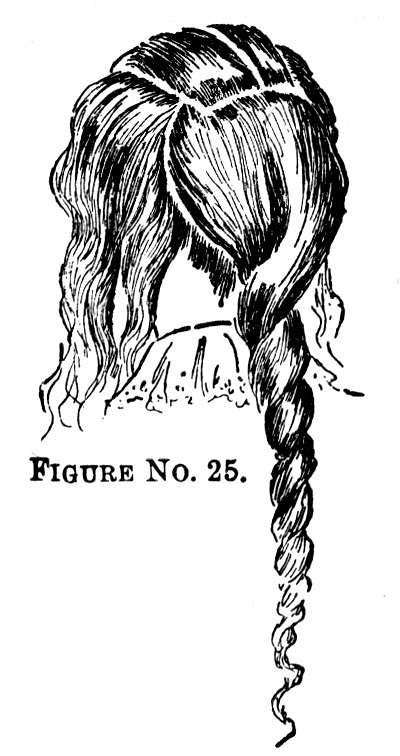
|

|
The waves, being brought thus low, ripple in a downward direction; and this unique feature may
be emphasized by drawing the sides down slightly over the ears. The hair may be arranged in a
braid, in which event three portions will be divided off, or in a rope coil, as in this instance,
two portions only being required, and one being simply twisted over the other. Thus, the right
portion is twisted over the left and then dropped; the left is twisted over the right and then
dropped; and so the coiling continues until the end is reached, the result being as portrayed at figure No. 28.
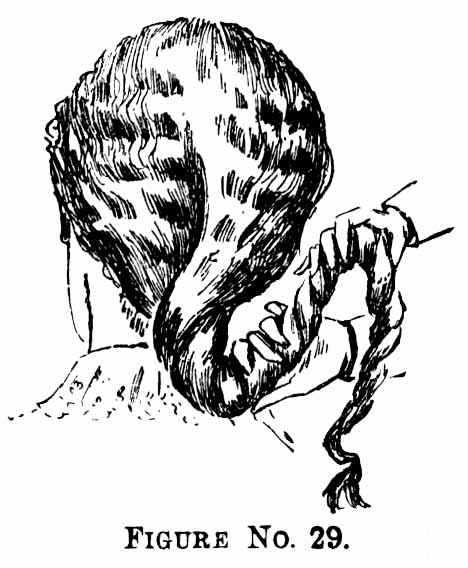
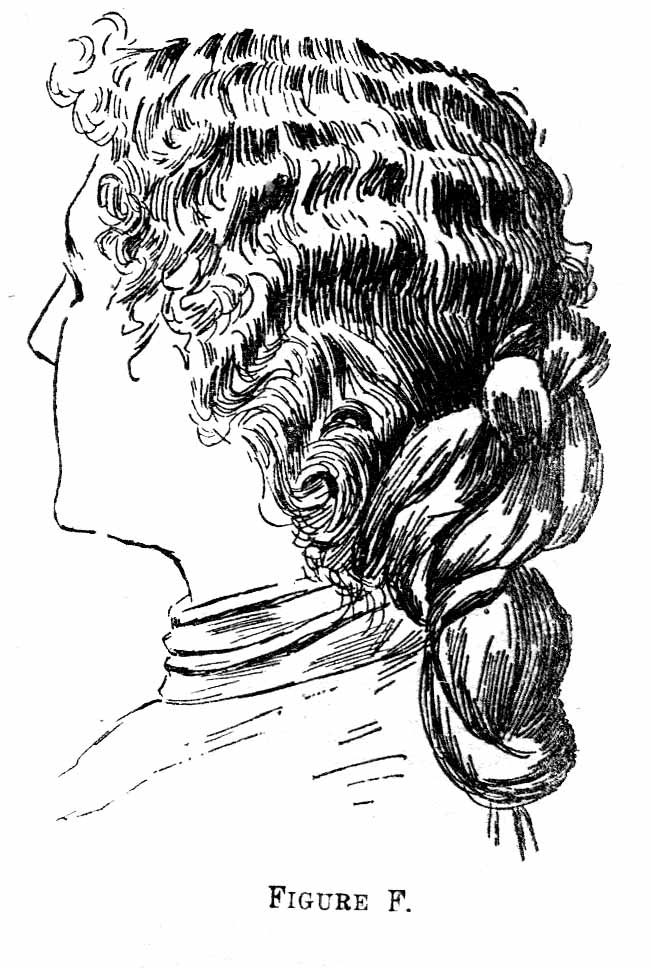 After the rope has been made, it is carried upward, as shown at figure No. 29, and twisted to form the “figure
eight,” as seen at figure F. The top of the "eight" coil extends about midway to the crown,
and the lower end falls quite a distance below the nape of the neck, the hair being secured with
hair-pins. The exact position of this coil, however, depends
largely upon the requirements of the face and head. A shell -hairpin (not a comb) may be thrust in at the top, or a
shell hair-buckle may fasten the coil at the center; and side-combs may be worn in the bang; or, if only a fringe bang
is cut, a shell bandeau or fillet may be disposed over the top of it to conceal its parting from
After the rope has been made, it is carried upward, as shown at figure No. 29, and twisted to form the “figure
eight,” as seen at figure F. The top of the "eight" coil extends about midway to the crown,
and the lower end falls quite a distance below the nape of the neck, the hair being secured with
hair-pins. The exact position of this coil, however, depends
largely upon the requirements of the face and head. A shell -hairpin (not a comb) may be thrust in at the top, or a
shell hair-buckle may fasten the coil at the center; and side-combs may be worn in the bang; or, if only a fringe bang
is cut, a shell bandeau or fillet may be disposed over the top of it to conceal its parting from
 the rest of the hair. The fillet is very fashionable and nearly always becoming,
and it may also be worn with the Newport coiffure when a fringe
bang is preferred to a parted one, the addition of the ornament giving the head a truly classic appearance.
the rest of the hair. The fillet is very fashionable and nearly always becoming,
and it may also be worn with the Newport coiffure when a fringe
bang is preferred to a parted one, the addition of the ornament giving the head a truly classic appearance.
When the front locks are very thin, a pretty bang is impossible; but a curled front-piece may be worn
without fear of detection, so cleverly are the so-called invisible fronts now constructed. At figure
No. 31 is shown the “Titus” bang, which extends quite to the crown in loose, natural-looking- curls
and ripples over the forehead very gracefully. Of course, .this band is only suited to a young face
and head, and it will be all the more effective if the back hair is plentiful.
Figure No. 32 represents a parted bang, which covers the entire front of the head, meeting the knot at
the back. Natural waves are arranged at each side of the parting, and two locks that are each curled
toward the center fall lightly on the forehead.
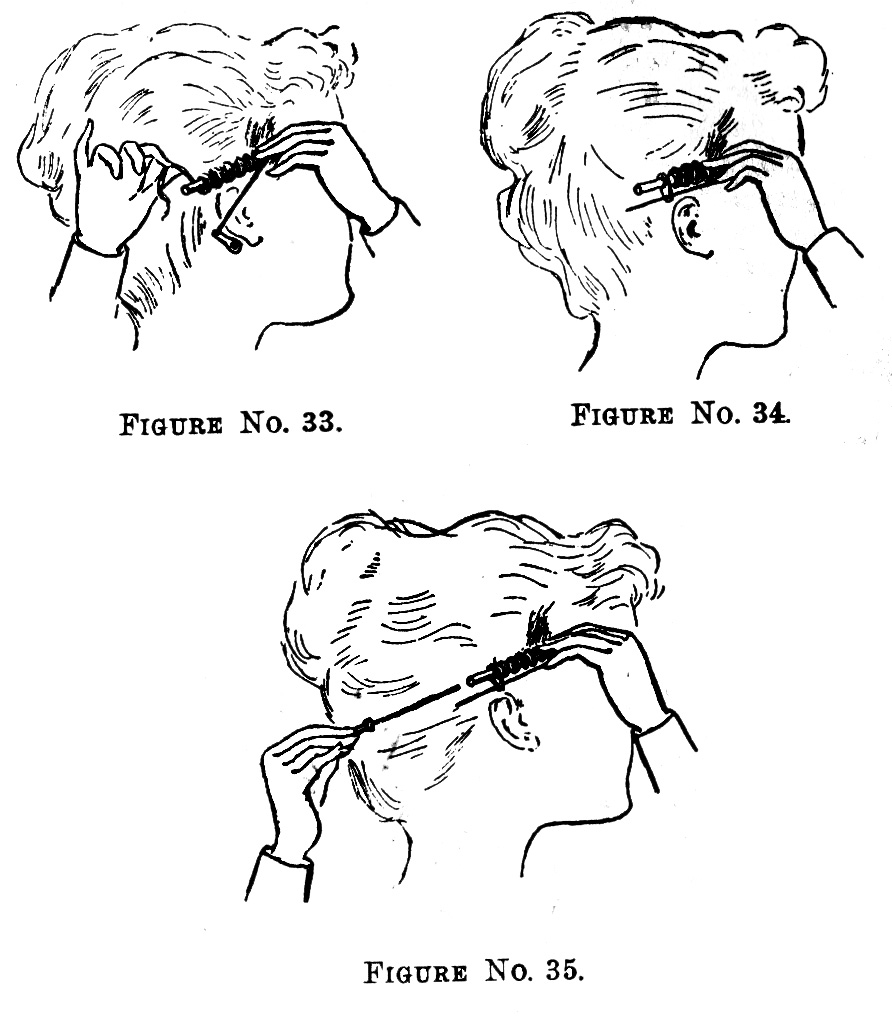 Another method of waving the hair is by means of the "Perfection Waver." This consists of a hollow
steel cylinder, to the top of which is hinged a rod that is furnished at the opposite end with a
movable clamp; and a separate steel rod with a wooden handle. At figure No. 33 a portion of the
hair the same thickness as would ordinarily be taken up for waving is shown twisted round and round
the cylinder. At figure No. 34 the hinged rod is brought down close to the hair, and the clamp is
adjusted over the cylinder to keep the hair from slipping. Figure No. 35 shows the method of
inserting in the cylinder the separate rod, properly heated to supply such a degree of warmth as will
produce natural-looking waves. All possibility of scorching the hair is avoided by the use of this
waver, which will be found as easy to manage as ordinary curling tongs.
Another method of waving the hair is by means of the "Perfection Waver." This consists of a hollow
steel cylinder, to the top of which is hinged a rod that is furnished at the opposite end with a
movable clamp; and a separate steel rod with a wooden handle. At figure No. 33 a portion of the
hair the same thickness as would ordinarily be taken up for waving is shown twisted round and round
the cylinder. At figure No. 34 the hinged rod is brought down close to the hair, and the clamp is
adjusted over the cylinder to keep the hair from slipping. Figure No. 35 shows the method of
inserting in the cylinder the separate rod, properly heated to supply such a degree of warmth as will
produce natural-looking waves. All possibility of scorching the hair is avoided by the use of this
waver, which will be found as easy to manage as ordinary curling tongs.
When false pieces, or even switches, are removed for the night, they should be carefully brushed and hung
up, that possible moisture may quickly escape. On damp days, or when the hair is naturally too moist or
oily, a fine, tinted drying powder may be dusted over the locks with a puff after they have been curled,
that they may retain their fluffiness. Only an occasional use of this powder is advised, however, since
frequent applications would affect the scalp unpleasantly.
Shell or steel-pointed hair-pins are best for securing the hair, and small, crimped, invisible pins should
be used to fasten stray locks.
The only hair ornaments now fashionable for dressy or ordinary occasions are shell or silver or gold-mounted
shell side-combs, high combs and pins, and shell fillets. Ribbon fillets, flowers, feathers and other
decorations of a similar nature are no longer approved by the best taste.
It is advisable to remove the dress bodice and assume a combing sack or towel before beginning to arrange
the hair, that the arms may move without restraint; and it is also well to sit during the entire process,
and thus save one's strength and, possibly, one's patience as well. To arrange an elaborate coiffure
properly requires considerable time, patience and skill, and if the operation is allowed to unduly tax
one‘s physical strength, the result will be a change for the worse in the expression of the face that will
detract not a little from the general appearance.
For much of the information and many of the suggestions presented above, and for the accessories
illustrated, we are indebted to the courtesy of Mr. A. Simonson, No. 933 Broadway, New-York City.
The Delineator, December 1894
*All of the illustrations present in the original
article have been reproduced; there were gaps in the numbering sequence.
|


